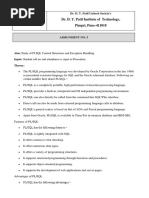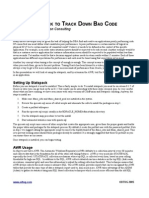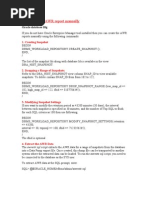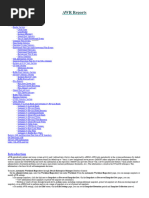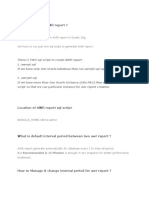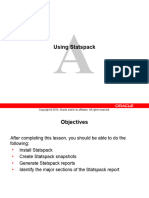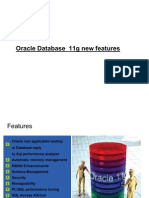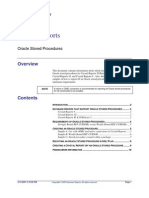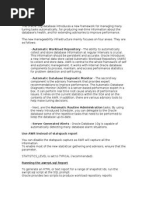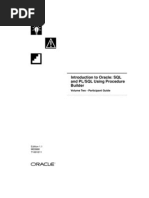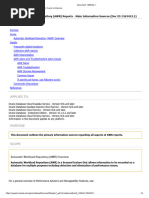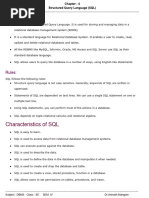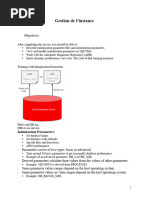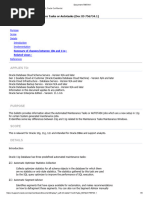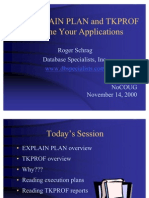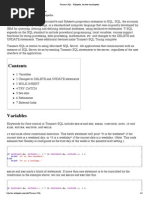Tips Perf Awr SQL Report 129542
Tips Perf Awr SQL Report 129542
Uploaded by
jorotadeburroCopyright:
Available Formats
Tips Perf Awr SQL Report 129542
Tips Perf Awr SQL Report 129542
Uploaded by
jorotadeburroCopyright
Available Formats
Share this document
Did you find this document useful?
Is this content inappropriate?
Copyright:
Available Formats
Tips Perf Awr SQL Report 129542
Tips Perf Awr SQL Report 129542
Uploaded by
jorotadeburroCopyright:
Available Formats
1ips on Perormance Diagnosis
Using A\R SQL Report
Tips on Performance Diagnosis Using AWR SQL Report Page 2
A\R SQL Report
INTRODUCTION
lae you eer looked through an A\R report and needed to see more inormation
about a particular SQL statement Or perhaps wanted to get more detail on a SQL
statement that may hae been perorming well one day, but had regressed the next
1his inormation is aailable in A\R and can be iewed using the A\R SQL
report that was introduced in Oracle Database 10gR2. 1he report proides
additional inormation or a SQL statement, including execution plans and
corresponding SQL statistics or the dierent execution plans.
GENERATING A RERORT
1he report is generated using the awrsqrpt.sql script in
$ORACLE_HOME/rdbms/admin.
Like the regular A\R report, this script will prompt you or a report ormat ,text
or html,, the number o days and a pair o begin,end snapshots. It will also
prompt or the sql_id on which to generate the report, along with a report name.
1he deault report name is
awrsqlrpt_<instance#>_<begin_snap>_<end_snap>.[html|txt]. Note that the
sql_id is not part o the report name, so i you are generating reports or multiple
sql_ids in the same snapshot range, name the reports appropriately.
SQL> @?/rdbms/admin/awrsqrpt
Current Instance
~~~~~~~~~~~~~~~~
DB Id DB Name Inst Num Instance
----------- ------------ -------- ------------
1185083199 ORCL 1 orcl
Specify the Report Type
~~~~~~~~~~~~~~~~~~~~~~~
Would you like an HTML report, or a plain text report?
Enter 'html' for an HTML report, or 'text' for plain text
Defaults to 'html'
Enter value for report_type: html
Type Specified: html
Instances in this Workload Repository schema
~~~~~~~~~~~~~~~~~~~~~~~~~~~~~~~~~~~~~~~~~~~~
DB Id Inst Num DB Name Instance Host
------------ -------- ------------ ------------ ------------
Use
$ORACLE_HOME/rdbms/admin/awrsqrpt
to generate the AWR SQL report
Tips on Performance Diagnosis Using AWR SQL Report Page 3
* 1185083199 1 ORCL orcl stacr30
Using 1185083199 for database Id
Using 1 for instance number
Specify the number of days of snapshots to choose from
~~~~~~~~~~~~~~~~~~~~~~~~~~~~~~~~~~~~~~~~~~~~~~~~~~~~~~
Entering the number of days (n) will result in the most recent
(n) days of snapshots being listed. Pressing <return> without
specifying a number lists all completed snapshots.
Enter value for num_days: 3
Listing the last 3 days of Completed Snapshots
Snap
Instance DB Name Snap Id Snap Started Level
------------ ------------ --------- ------------------ -----
orcl ORCL 561 07 Jul 2008 00:00 1
562 07 Jul 2008 01:00 1
563 07 Jul 2008 02:00 1
564 07 Jul 2008 03:00 1
565 07 Jul 2008 04:00 1
...
623 09 Jul 2008 14:00 1
624 09 Jul 2008 15:00 1
Specify the Begin and End Snapshot Ids
~~~~~~~~~~~~~~~~~~~~~~~~~~~~~~~~~~~~~~
Enter value for begin_snap: 623
Begin Snapshot Id specified: 623
Enter value for end_snap: 624
End Snapshot Id specified: 624
Specify the SQL Id
~~~~~~~~~~~~~~~~~~
Enter value for sql_id: f3cmbb55dvgr1
SQL ID specified: f3cmbb55dvgr1
Specify the Report Name
~~~~~~~~~~~~~~~~~~~~~~~
The default report file name is awrsqlrpt_1_623_624.html. To use this
name,
press <return> to continue, otherwise enter an alternative.
Enter value for report_name:
Using the report name awrsqlrpt_1_623_624.html
REPORT CONTENTS
1he irst part o the report is similar to the regular A\R report. It proides general
inormation on the database name, instance, the host name. It also includes
inormation about the begin,end snapshots, the elapsed time as well as the DB
time accumulated between the two snapshots.
Tips on Performance Diagnosis Using AWR SQL Report Page 4
SQL Summary
1he SQL summary section shows the SQL Id, the total elapsed time accumulated
and a ragment o the sql text, hyperlinked to the ull SQL text at the bottom o the
report. It also includes summary statistics or the execution plans captured during
the interal or that one sql_id.
In the ollowing screenshot, we see there are two execution plans captured or the
SQL Id during the snapshot interal. lrom this summary, we see that 41 was
executed more oten. \e also see that both plans were captured during the
snapshot id 624.
Execution PIans and Statistics
1he report then shows the details or each o the execution plans - including SQL
statistics and along with the execution plan. 1he plan statistics can be used to
compare the perormance o the dierent execution plans that occurred during the
interal. 1he execution plans can then be examined to determine the dierence in
perormance between the plans.
lrom the ollowing screen shots, we see that 41 was executed more oten, and
incurred less elapsed time and cpu time per execution than 42. 1he dierence in
per execution statistics is minimal which would indicate that these two plans are
comparable in perormance.
Tips on Performance Diagnosis Using AWR SQL Report Page 5
Tips on Performance Diagnosis Using AWR SQL Report Page 6
In order to analyze a SQL statement that has regressed rom one day to another,
simply generate an A\R SQL report or a time when the SQL statement was
perorming well, and a second A\R SQL report or a comparable time when the
SQL statement was perorming poorly. 1he execution plans and the statistics can
then be compared between the two reports to determine why the SQL statement
has regressed. Not all regressions are due to plan changes - it may be that the
statement is executed more oten, retriees more data, or incurs more wait time.
Comparing both the statistics and the execution plans can help determine the cause
o the regression.
EM SCREENS
1he inormation in the A\R SQL report is also aailable in the LM Perormance
screens.
1here is a drop down menu to choose the plan hash alue or which to display the
SQL statistics.
CONCLUSION
1he A\R SQL report shows detailed SQL inormation that is aailable in the LM
perormance pages. 1his report can be used to compare the execution plans and
the execution statistics o SQL statements, and proides additional detail or SQL
that is not aailable in a regular A\R report.
Tips on Performance Diagnosis Using AWR SQL Report
JuIy 2008
OracIe Corporation
WorId Headquarters
500 OracIe Parkway
Redwood Shores, CA 94065
U.S.A.
WorIdwide Inquiries:
Phone: +1.650.506.7000
Fax: +1.650.506.7200
oracIe.com
Copyright 2008, OracIe and/or its affiIiates. AII rights reserved.
This document is provided for information purposes onIy and the
contents hereof are subject to change without notice.
This document is not warranted to be error-free, nor subject to any
other warranties or conditions, whether expressed oraIIy or impIied
in Iaw, incIuding impIied warranties and conditions of merchantabiIity
or fitness for a particuIar purpose. We specificaIIy discIaim any
IiabiIity with respect to this document and no contractuaI obIigations
are formed either directIy or indirectIy by this document. This document
may not be reproduced or transmitted in any form or by any means,
eIectronic or mechanicaI, for any purpose, without our prior written permission.
OracIe is a registered trademark of OracIe Corporation and/or its affiIiates.
Other names may be trademarks of their respective owners.
You might also like
- Assignments DBMS 5-8Document27 pagesAssignments DBMS 5-8Anonymous pStrXsEQVb33% (9)
- Using Statspack To Track Down Bad CodeDocument11 pagesUsing Statspack To Track Down Bad CodeMichael AultNo ratings yet
- How To Create AWR Report ManuallyDocument3 pagesHow To Create AWR Report ManuallydbareddyNo ratings yet
- AWR ReportsDocument30 pagesAWR ReportsSamuel AsmelashNo ratings yet
- PL SQL Document by MVDocument95 pagesPL SQL Document by MVmahhy_vishNo ratings yet
- Real Application TestingDocument35 pagesReal Application Testingsap hanaNo ratings yet
- AWR - Automatic Workload RepositoryDocument19 pagesAWR - Automatic Workload RepositoryModesto Lopez RamosNo ratings yet
- Generando Reportes AWR, ASH y ADDM PDFDocument4 pagesGenerando Reportes AWR, ASH y ADDM PDFModesto Lopez RamosNo ratings yet
- AWR ReportDocument3 pagesAWR ReportdiranjNo ratings yet
- D79236GC10 Appendix ADocument20 pagesD79236GC10 Appendix AcomercialNo ratings yet
- Oracle Database 11g New FeaturesDocument21 pagesOracle Database 11g New FeaturesGampa SatheeshNo ratings yet
- AWR Architecture: - V$Sess - Time - Model V$Sys - Time - Model - V$Active - Session - History - V$Sysstat V$SesstatDocument11 pagesAWR Architecture: - V$Sess - Time - Model V$Sys - Time - Model - V$Active - Session - History - V$Sysstat V$SesstatThoufic SNo ratings yet
- Crystal Report SupportDocument10 pagesCrystal Report SupportAbhijeet BhanjadeoNo ratings yet
- Addmrpt 1 36561 36562Document5 pagesAddmrpt 1 36561 36562Anonymous ZGcs7MwsLNo ratings yet
- SRW Package in Oracle ReportDocument10 pagesSRW Package in Oracle ReportRocky JwalaNo ratings yet
- AWRDocument2 pagesAWRAshish GuptaNo ratings yet
- DB12c Tuning New Features Alex Zaballa PDFDocument82 pagesDB12c Tuning New Features Alex Zaballa PDFGanesh KaralkarNo ratings yet
- OCP - SQL&PL - SQL (Vol2)Document348 pagesOCP - SQL&PL - SQL (Vol2)api-3814149No ratings yet
- Oracle AWR ReportDocument64 pagesOracle AWR ReportsmslcaNo ratings yet
- Automatic Workload Repository (AWR) Reports - Main Information Sources (Doc ID 1363422.1)Document4 pagesAutomatic Workload Repository (AWR) Reports - Main Information Sources (Doc ID 1363422.1)mudassar.azizi1980No ratings yet
- Chapter 4 - Structured Query Language - (SQL)Document9 pagesChapter 4 - Structured Query Language - (SQL)roshanjadhav2023No ratings yet
- Oracle AWR (Automatic Workload Repository) TrendingDocument6 pagesOracle AWR (Automatic Workload Repository) TrendingkruemeL1969No ratings yet
- Configuration Guide: Smartconnector™ For Oracle Audit DBDocument21 pagesConfiguration Guide: Smartconnector™ For Oracle Audit DBjakpykeNo ratings yet
- TP 5.1 Gestion Instance OCI (1)Document32 pagesTP 5.1 Gestion Instance OCI (1)ghassanebougerfaoui2004No ratings yet
- The Oracle AWR Introduce and Reports Analysis Final PDFDocument32 pagesThe Oracle AWR Introduce and Reports Analysis Final PDFModesto Lopez RamosNo ratings yet
- Addmrpt 1 36560 36561Document7 pagesAddmrpt 1 36560 36561Anonymous ZGcs7MwsLNo ratings yet
- Document 756734.1Document6 pagesDocument 756734.1dinermiNo ratings yet
- Use Explain PlanDocument53 pagesUse Explain PlanRiaz Sheikh100% (1)
- Awr RecreateDocument2 pagesAwr RecreateRaj KumarNo ratings yet
- Automatic Workload RepositoryDocument9 pagesAutomatic Workload RepositoryBeaNo ratings yet
- Configuration Guide: Smartconnector For Microsoft SQL Server Multiple Instance Audit DBDocument37 pagesConfiguration Guide: Smartconnector For Microsoft SQL Server Multiple Instance Audit DBjakpykeNo ratings yet
- OracleProf - 2004 - 05Document16 pagesOracleProf - 2004 - 05JMendezTrNo ratings yet
- 10g Wait ImprovementsDocument3 pages10g Wait ImprovementsPatricio SilvaNo ratings yet
- Overview of Wait Event ModelDocument3 pagesOverview of Wait Event ModelPatricio SilvaNo ratings yet
- Transact-SQL: Transact-SQL (T-SQL) Is Microsoft's and Sybase's Proprietary Extension To SQL. SQL, The AcronymDocument4 pagesTransact-SQL: Transact-SQL (T-SQL) Is Microsoft's and Sybase's Proprietary Extension To SQL. SQL, The AcronymddcvNo ratings yet
- TrainingDocument52 pagesTrainingvenkat.sqlNo ratings yet
- PL SQLDocument123 pagesPL SQLthakkarparth793No ratings yet
- Dam Project ReportDocument35 pagesDam Project ReportMuhammad SardaarNo ratings yet
- Tracing Bind Variables and Waits 20000507Document5 pagesTracing Bind Variables and Waits 20000507José Laurindo ChiappaNo ratings yet
- Programming With Transact-SQLDocument44 pagesProgramming With Transact-SQLrsmith456No ratings yet
- Oracle Apps FAQDocument221 pagesOracle Apps FAQkartikey_becs100% (2)
- Oracle DBA Interview PERFORMANCE TUNING Question-1Document7 pagesOracle DBA Interview PERFORMANCE TUNING Question-1RahumassNo ratings yet
- Enhanced SQL Trace Utility From Oracle: Oracle Tips by Burleson ConsultingDocument19 pagesEnhanced SQL Trace Utility From Oracle: Oracle Tips by Burleson Consultinganjani1999No ratings yet
- Auditing Oracle DatabasesDocument8 pagesAuditing Oracle DatabasesahamedshihabNo ratings yet
- Customer Performance Issue Report - CommonDocument7 pagesCustomer Performance Issue Report - Commonvadas.razvojNo ratings yet
- StatspackDocument12 pagesStatspackbalajismithNo ratings yet
- Data Lake AzureDocument290 pagesData Lake Azurelegionario15No ratings yet
- AG6_Performance_tuning_and_monitoring_the_Autonomous_DB_(SQL+Monitoring)_ed3Document26 pagesAG6_Performance_tuning_and_monitoring_the_Autonomous_DB_(SQL+Monitoring)_ed3govindarao dbaNo ratings yet
- Awr ReportDocument9 pagesAwr ReportHemendra SinghNo ratings yet
- Locating Similar SQL in OracleDocument5 pagesLocating Similar SQL in Oracleapi-3759101No ratings yet
- Document 1448324.1Document6 pagesDocument 1448324.1Sugaintheran MuniandyNo ratings yet
- SQLDocument3 pagesSQLNagarajuNo ratings yet
- Addmrpt 1 1440 1441Document9 pagesAddmrpt 1 1440 1441GustavoSebastiánOrtegaNo ratings yet
- Unit 3 Advanced SQLDocument44 pagesUnit 3 Advanced SQLYesudasNo ratings yet
- Addmrpt 1 36558 36559Document7 pagesAddmrpt 1 36558 36559Anonymous ZGcs7MwsLNo ratings yet
- Oracle SQL Revealed: Executing Business Logic in the Database EngineFrom EverandOracle SQL Revealed: Executing Business Logic in the Database EngineNo ratings yet
- Beginning jOOQ: Learn to Write Efficient and Effective Java-Based SQL Database OperationsFrom EverandBeginning jOOQ: Learn to Write Efficient and Effective Java-Based SQL Database OperationsNo ratings yet
- SQL Server 2019 AlwaysOn: Supporting 24x7 Applications with Continuous UptimeFrom EverandSQL Server 2019 AlwaysOn: Supporting 24x7 Applications with Continuous UptimeNo ratings yet
- High Performance SQL Server: Consistent Response for Mission-Critical ApplicationsFrom EverandHigh Performance SQL Server: Consistent Response for Mission-Critical ApplicationsNo ratings yet
- Pro SQL Server 2019 Wait Statistics: A Practical Guide to Analyzing Performance in SQL ServerFrom EverandPro SQL Server 2019 Wait Statistics: A Practical Guide to Analyzing Performance in SQL ServerNo ratings yet
